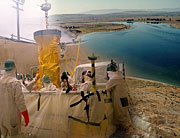- Number 300 |
- November 23, 2009
Where did the uranium go?

Research shows that the
concentration of carbonate and
the pH of the groundwater can
slow uranium’s progress toward
waterways.
Based on experiments and modeling, scientists at Pacific Northwest National Laboratory are learning how the chemistry brought on by a river's changing levels slows uranium's movement in the surrounding soil. The research shows uranium's migration is influenced by the groundwater’s pH and carbonate levels. Uranium attaches to soil particles and moves slowly when the groundwater is at neutral pH and contains low levels of carbonate ions—conditions that often occur along shorelines when the river water rises and mixes with the groundwater. To control uranium's fate and transport, scientists must understand how fast uranium attaches to and releases from soil particles under different chemical conditions.
[Kristin Manke, 509.372.6011,
kristin.manke@pnl.gov]
